Nelson Creek to Reefton
Just a short 45 min (59km) drive from Nelson Creek is the small township of Reefton. Now I say small, but this wee town sure packs a punch when it comes to its history.
Reefton – The Town of Light
This small unassuming settlement proudly boasts its own ‘claim to fame’.
In 1888 Reefton became the first town in New Zealand (in fact the entire Southern Hemisphere) to receive commercial electricity, generated by the Reefton Power Station. This was even before the more fashionable locations such as New York and London.
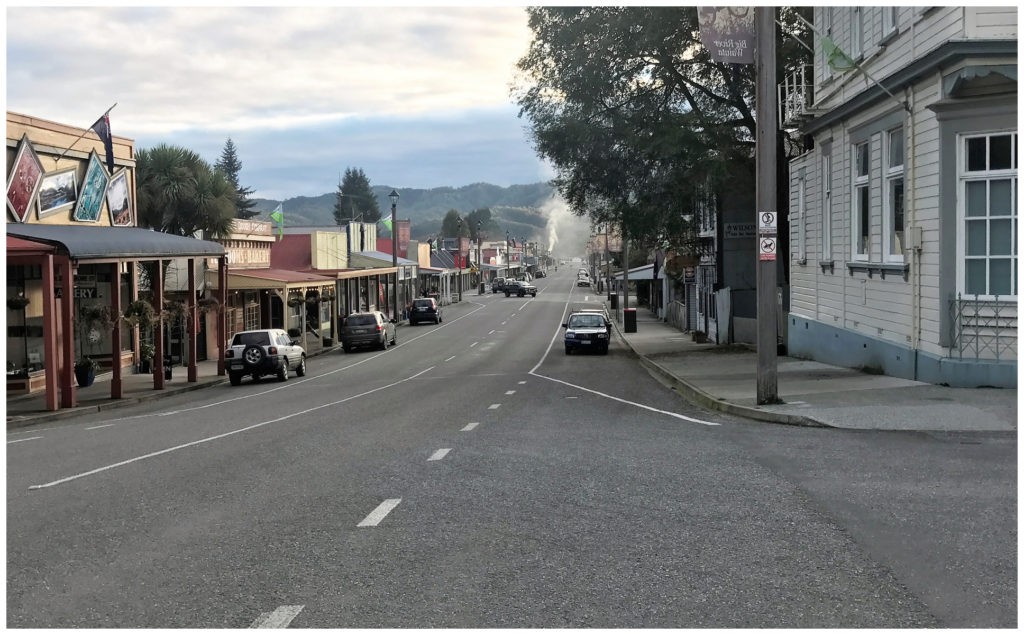
Lots of character and charm in the main street of Reefton
We were keen on spending some time in Reefton to find out more about our next ‘small town NZ’ destination.
Accommodation
We knew that there were a number of options for parking up in and around Reefton. We decided that our best option would be to stopover at the Reefton Motor Camp (NZMCA#6534). It is centrally located beside the Inangahua River, close to town and also the Powerhouse Walk.
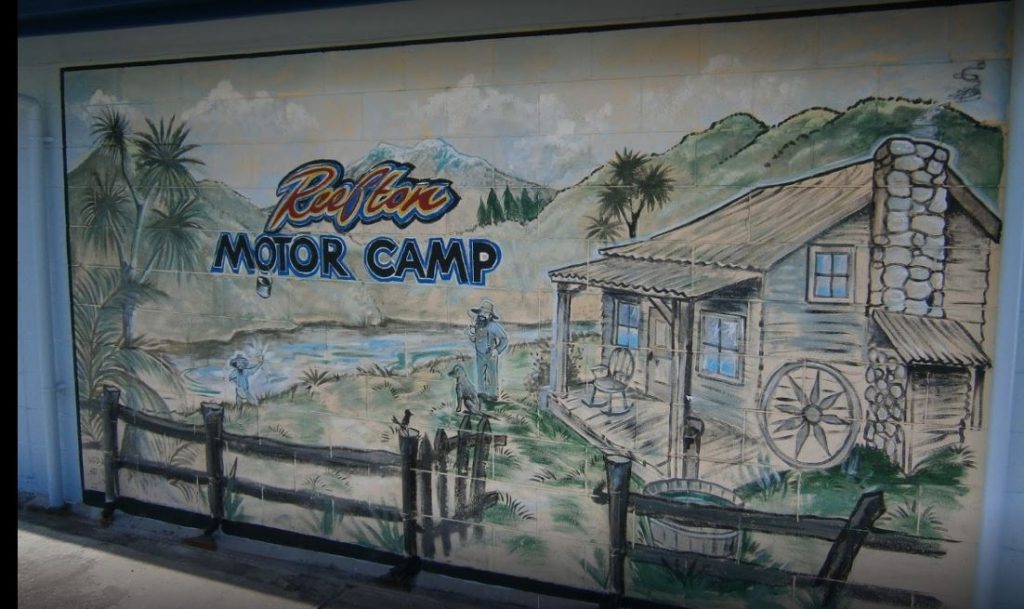
We parked up on a firm hardstand powered site. The ablution block was close by with clean hot showers, toilets, a spacious kitchen and laundry. It cost us $30 per night which is the ‘upper end’ of the scale of what we like to pay.
Bottled Lightning Powerhouse Walk
Once we were all set up, we were keen to start exploring. We wandered down the road to the suspension bridge and followed the old Powerhouse walk.
The 40-minute loop track follows the river to the site of the original Power Station. It is a great track with loads of information boards along the way, explaining the history surrounding the story behind Reefton’s claim to fame.
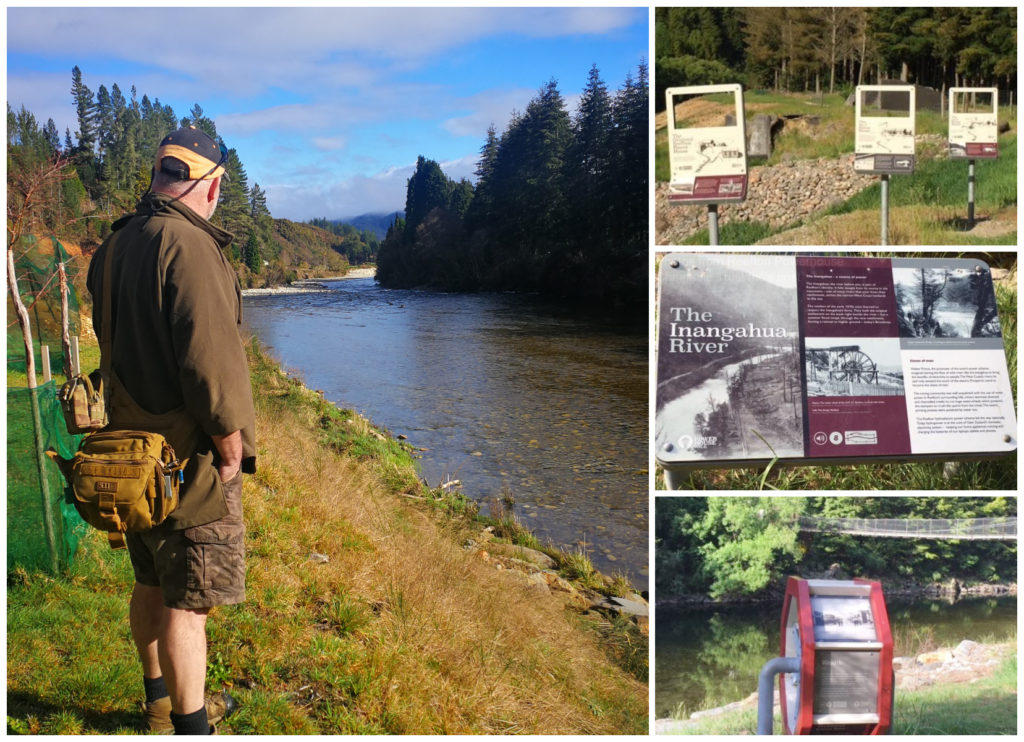
They’ve done an amazing job with erecting so many history boards along the walk and Scotty contemplating life beside the Inangahua River….lol.
The power station used water from the Inangahua River. After the town was connected to the National Grid in 1949, the power station was decommissioned and then later demolished in 1961.
Historic Town Walk
After completing the loop, we continued to follow the Historic Town Walk.
We quickly noticed that Reefton is quite a curious mix of the old and new. Thankfully its historic charm has been maintained as many of the heritage buildings have been restored, keeping their iconic features. Our wanderings offered us an insight into the past.
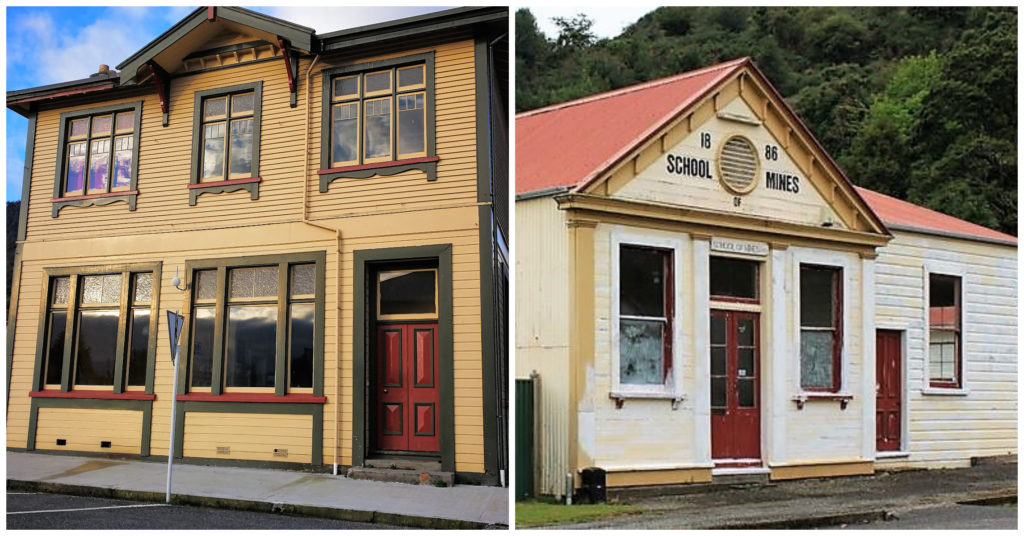
Although the walk is only around 30 minutes, it includes 24 historic buildings from the 19th century. These include a variety of shops, churches, lodges, hotels, halls, courthouse and the Reefton School of Mines (established in 1886).
I was particularly fascinated by the Oddfellows Hall. It boasts the first light that was powered just above the entranceway.
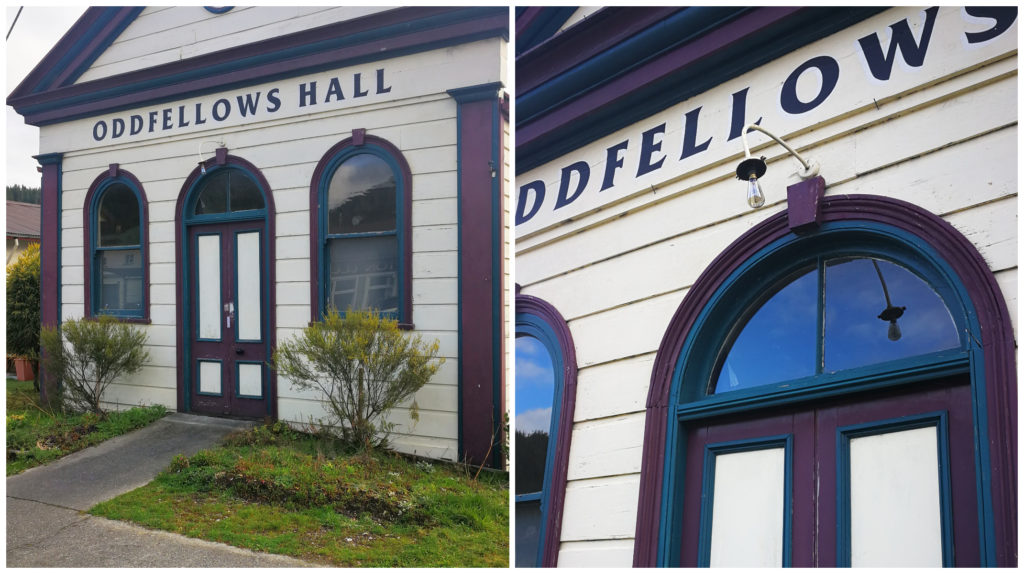
I found the Oddfellows Hall and the first powered street light!
Reefton Distilling Co
I had been reading some good things about the young up and coming Reefton Distilling Co. Not all gins are created equally so I was keen to discover just what all the hype was about with this small distillery.
Reefton Distilling Co is located in one of Reefton’s original buildings which have been restored to house their working distillery, tasting bar and retail store.
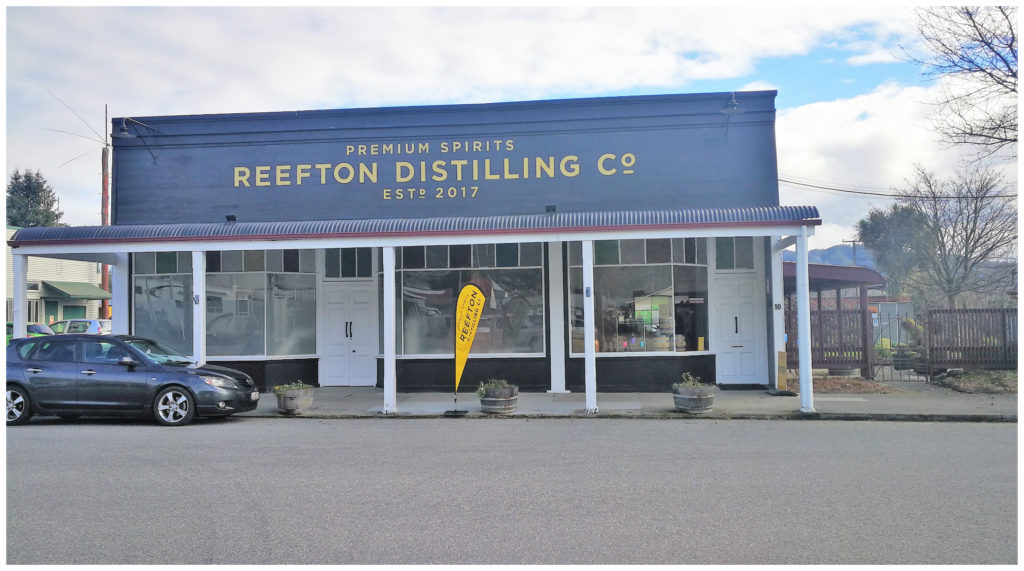
The carefully renovated fit for purpose distillery
Although they offer a range of distillery tours, we were more interested in partaking in the tasting (purely for scientific purposes of course!).
Shane (the man behind the counter) was passionate and enthusiastic when it came to explaining the origins of the distillery. He spent time explaining the process and the unique ingredients that went into all of their products. Many of these ingredients can only be sourced deep in the dense forests of the West Coast region. These include native leaves, moss, flowers and berries.
Tastings
With my first sip of Little Biddy Gin, I could taste the earthy (almost barky) after taste left behind. They call it ‘gin with attitude’ just like its namesake. Little Biddy takes its name from Bridget Goodwin, a pipe-smoking, gin-toting, 4-foot tall gold miner. Looking at her photo, she’s not someone you would want to cross!
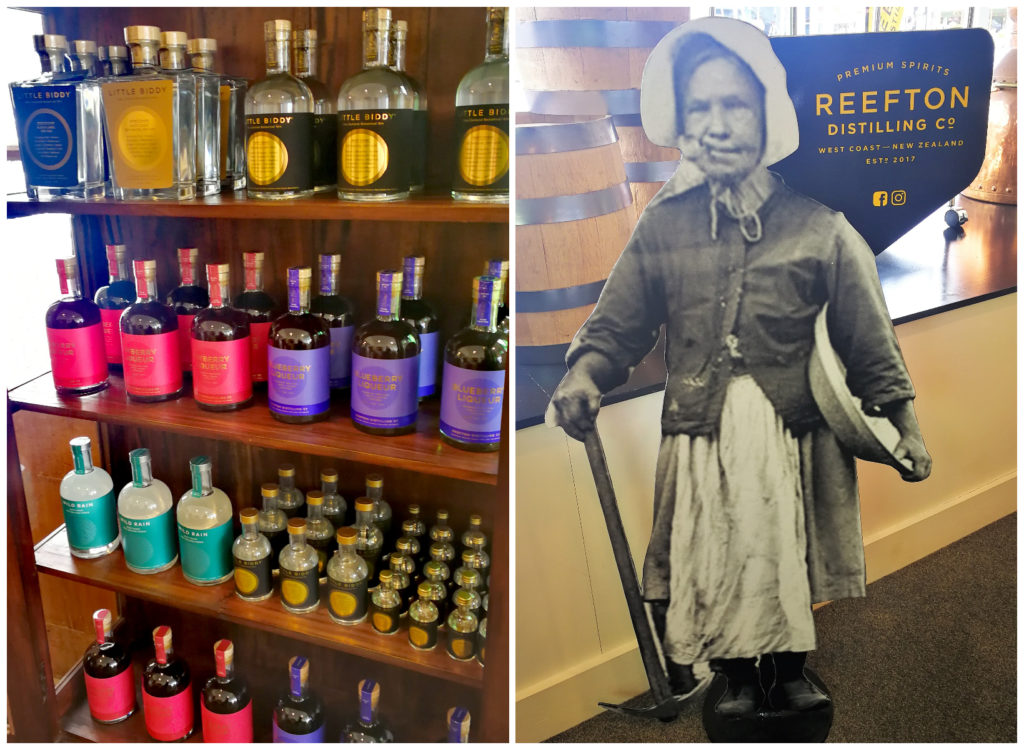
Their colourful range of products and a life-size cut-out of Little Biddy
We spent time sampling their full range of gin, vodka and liqueurs (blueberry and tayberry). Although I would have loved a bottle of each, I resisted and walked away with a bottle of Little Biddy Gin. I decided that I would treat myself to a liqueur the next time around.
The Bearded Mining Company
We had heard that The Bearded Mining Company at the Miners Hut was a ‘must-do’ when visiting Reefton. As it is located right in the heart of town, we popped in to say hello.
From what we had read, you can call in and learn how a miner lived in the 19th century, sit in front of the fire with a cup of billy tea and watch how pieces of iron and steel are shaped on the blacksmith forge. You can also try your hand at gold panning.
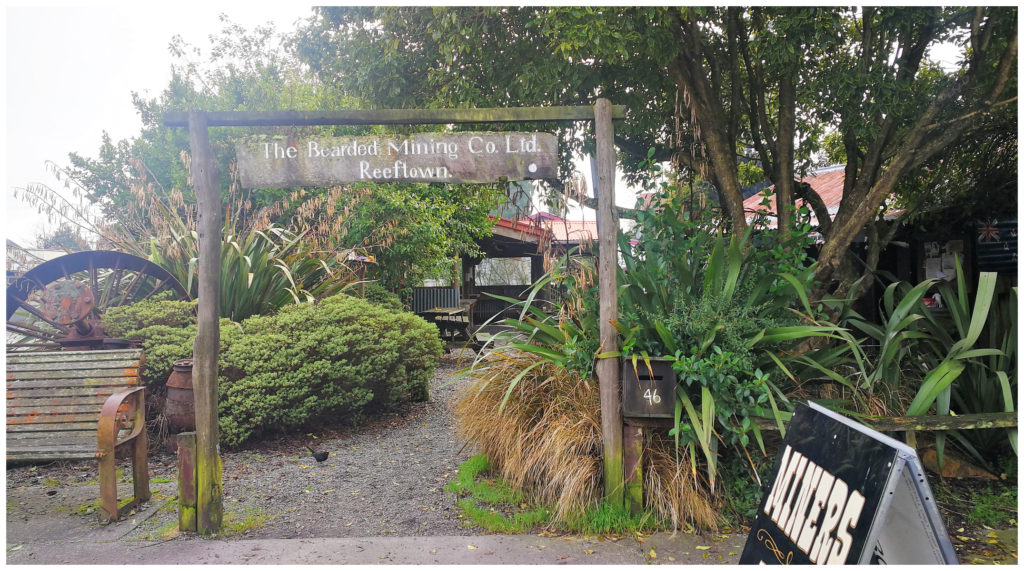
Handy location in the middle of the main street
Well, I’m not sure if it was because they were feeling the winter chill, but the half dozen old guys gathered around the fire seemed to be a bit disinterested in sharing much information or stories with us. The conversation was difficult to glean out of them and there was really only one member of the gang who seemed remotely interested in chatting with us.
My interest wanned even more when I found out that only one of them was actually an old miner. The rest stemmed from the forestry industry. So much for chatting about the ‘old days’ at the mine site!
Anyway, we had a discussion with one of them about the future of the upcoming gold exploration up by Snowy Creek (Waiuta) and the prospects of future jobs and the benefits for Reefton.
I left some money for them under the teapot for their ‘morning tea kitty’ and we continued on our way. Maybe we just caught them on an ‘off’ day. Summer might be a better time to visit.
Waiuta Ghost Town
Located 21 km south of Reefton in Ikamatua, Waiuta was the location of a historic gold mining town. Unlike many of the old mining sites we’ve visited throughout the West Coast, Waiuta has a more recent history.
History
Now abandoned, it is considered one of NZ’s most popular ghost towns. Gold was mined in the area for decades before they hit the ‘motherload’. The first gold Quartz Reef was found in 1905 and the first mine shaft operated in 1908 called the Blackwater Shaft (593m deep!). The mine was extended in 1926 with the opening of the Prohibition Shaft (a whopping 879m deep) which is a short drive further up the hill. The mine produced 750,000 ounces of gold and by the early 1920s, a town was beginning to form.
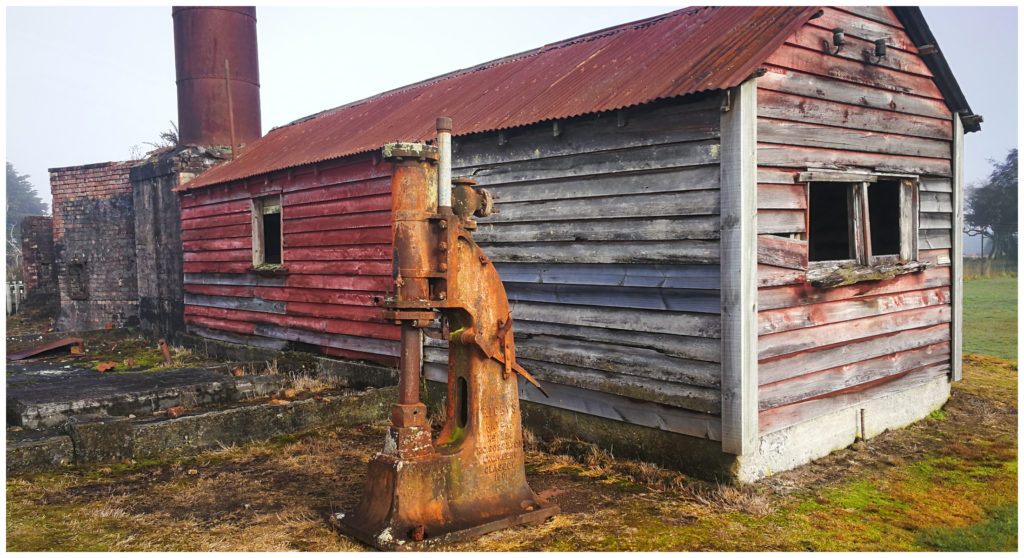
Derelict buildings beside the shaft of the Blackwater Mine
These mines were the second largest gold producing sites in the country, second to the Waihi mine in the North Island.
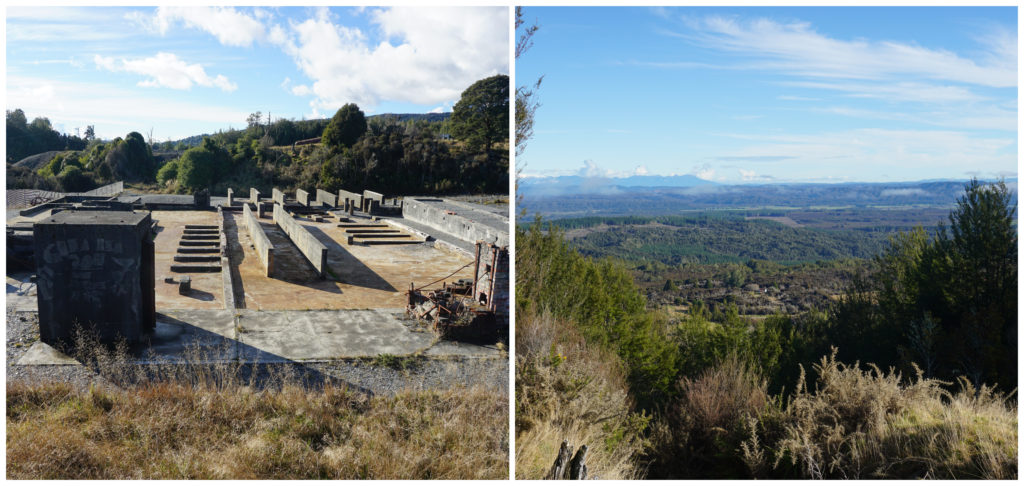
A short drive up the hill brings you to the Prohibition Mine and building foundations
Unfortunately in 1951 one of the shafts collapsed and the company deemed it too uneconomical to continue. This also coincided with a pay dispute with the miner’s wages which only encouraged the company to ‘shut up shop’.
Waiuta Town
Although the history of the mine was fascinating, it was the town and its inhabitants and way of life that captivated us the most.
We parked the ute at the start of the town and spent a good couple of hours wandering the old streets of the town. The site of the old Post Office provided us with a snapshot of what the town looked like, what was on offer for its residents and what life was like living in Waiuta.
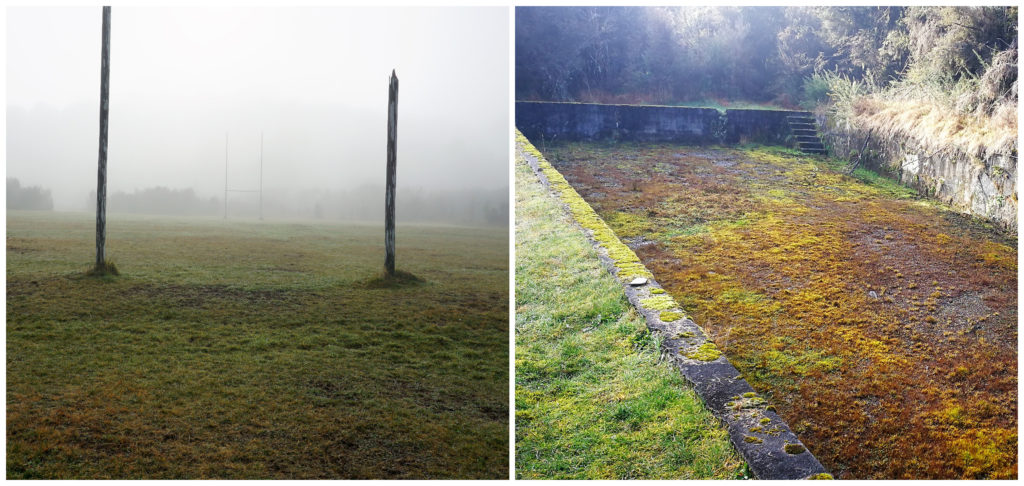
The swimming pool must have been quite the place to be in the summer and the rugby grounds would have been well used in the winter
Retracing the footsteps of the miners and their families we located the sites of the former police station, cottages, barbershop, sports field (rugby being the sport of choice), tennis court, swimming pool, hospital, Workingmans Club, hotels and school.
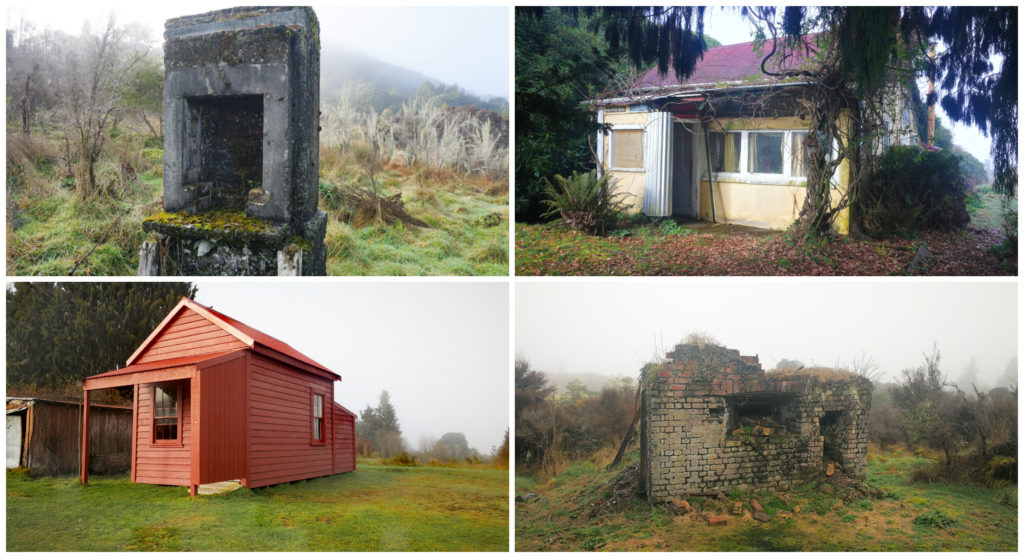
Some buildings have been restored but others lie in different stages of decay
Although a lot of the structures are gone, there are still some that are intact and it is a shame that more could not have been done to preserve the memory of those that lived their lives here.
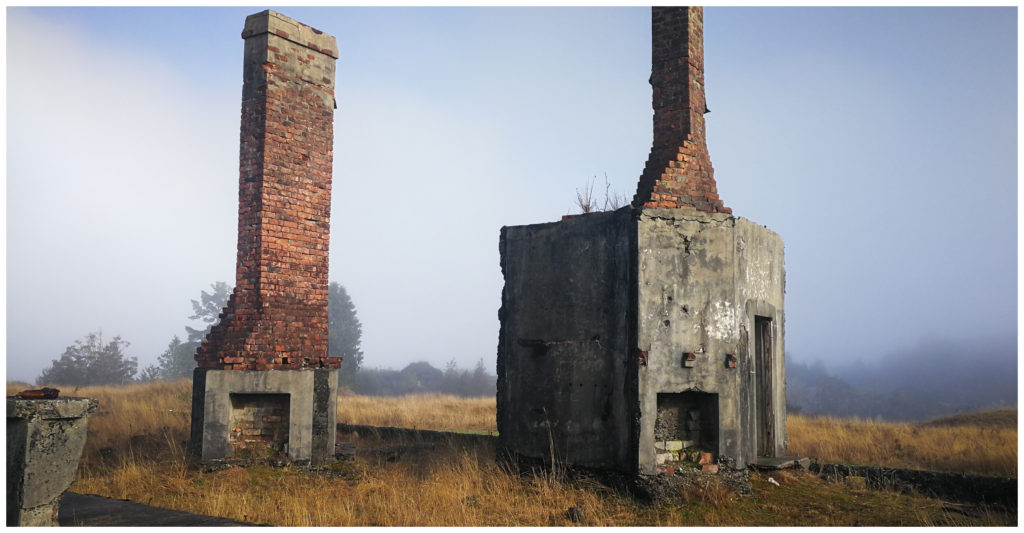
the descending mist added to the ghostly outline of what was the Croquet and Workingmans Clubrooms
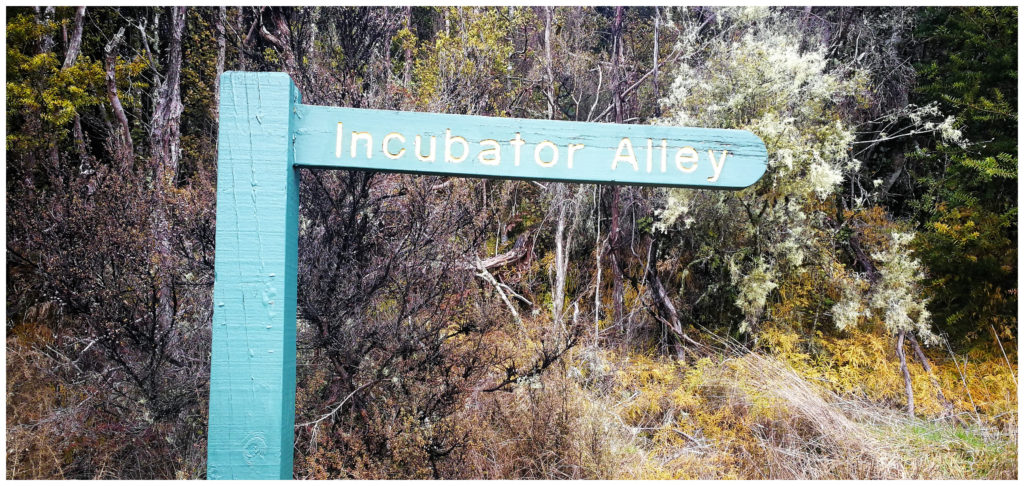
many babies were born at the hospital and this road got its name as the 6 families that lived here, there were 54 children between them!!!
Photos Through the Eyes of a Miner
One of the locals in Waiuta was Joseph Divis. He was born in what is now known as the Czech Republic and migrated to NZ in 1909. Luckily for us, he was an avid photographer as well as a miner. He lived most of his adult life at Wauta and captured the essence of Waiuta on carefully composed glass negatives.
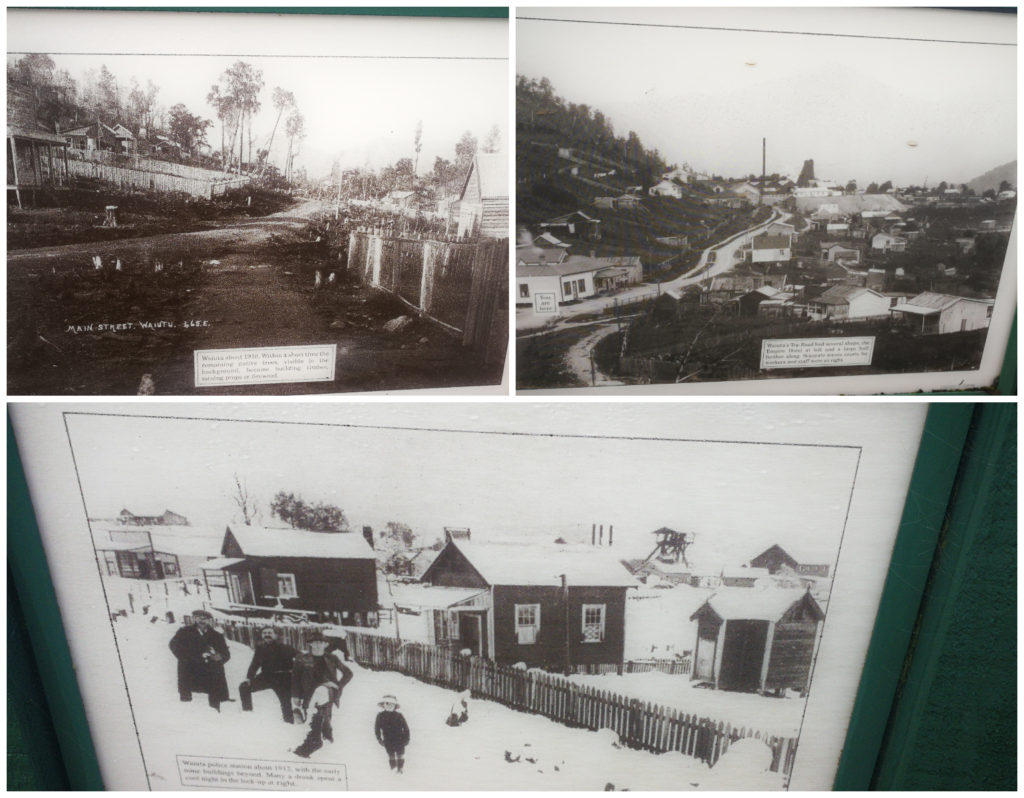
So many photos taken by Joseph captured life at Waiuta
All the photographs that appear on the numerous history boards dotted around the town are thanks to his hobby of photography. It recorded fascinating moments in time, many with him in the photo (thanks to using a shutter time-release) during the 1920s and 30s.
We located his cottage and although still standing, in quite a state of disrepair. We respectfully tiptoed our way around the inside amongst what we initially thought may have still been some of his belongings. The date on many of the strewn papers and books indicated that it was more from squatters than the man himself, who passed away in 1967.
Snowy Creek Battery and Powerhouse Walk
After wandering the streets of the old township, we made our way to the start of the Snowy Creek Battery Walk. This loop track took us around 2.5hrs and lead us downhill to the Snowy River Battery and then to the foundations of the old Powerhouse.
The Battery
Ore was transported by horse from the Backwater Mine, then carried by incline tramway to the battery. The track led us to the remains of a massive gold extraction plant.
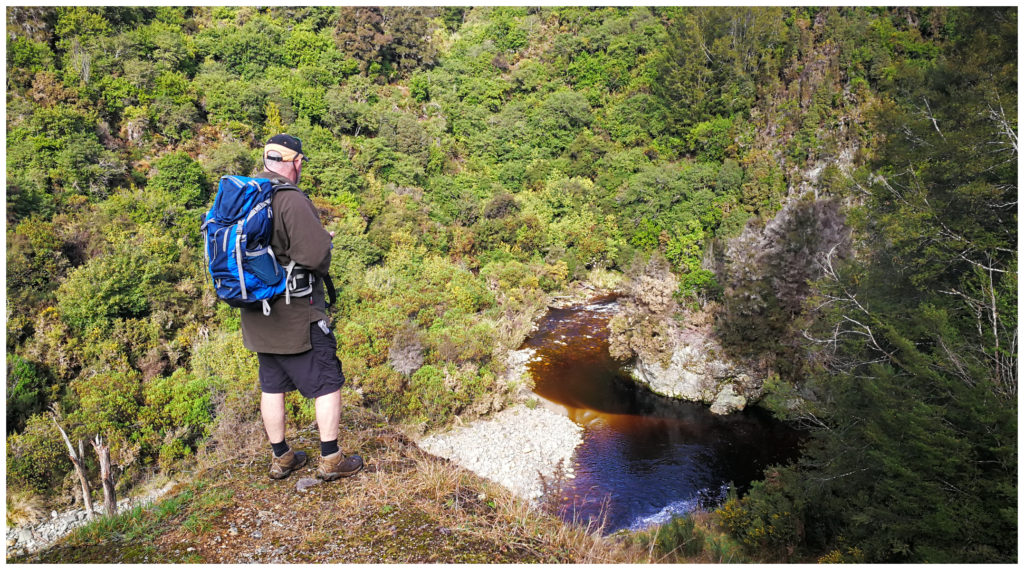
Making our way down to the battery – the tannin-stained waterways
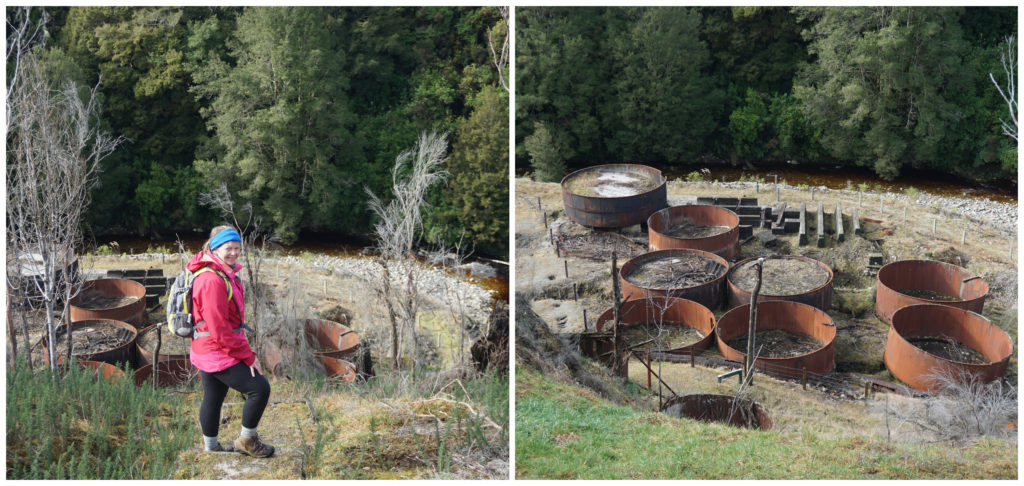
The cyanide tanks strategically placed close to the stream for the disposal of the chemicals….WHAT!!!!!
We could clearly see the foundations of the old structures and the large rotting cyanide tanks.
The quartz was pounded to powder by heavy stamps and the gold was saved by treating it with cyanide. The tainted tailings were then disbursed into the stream below. What an absolute environmental tragedy!
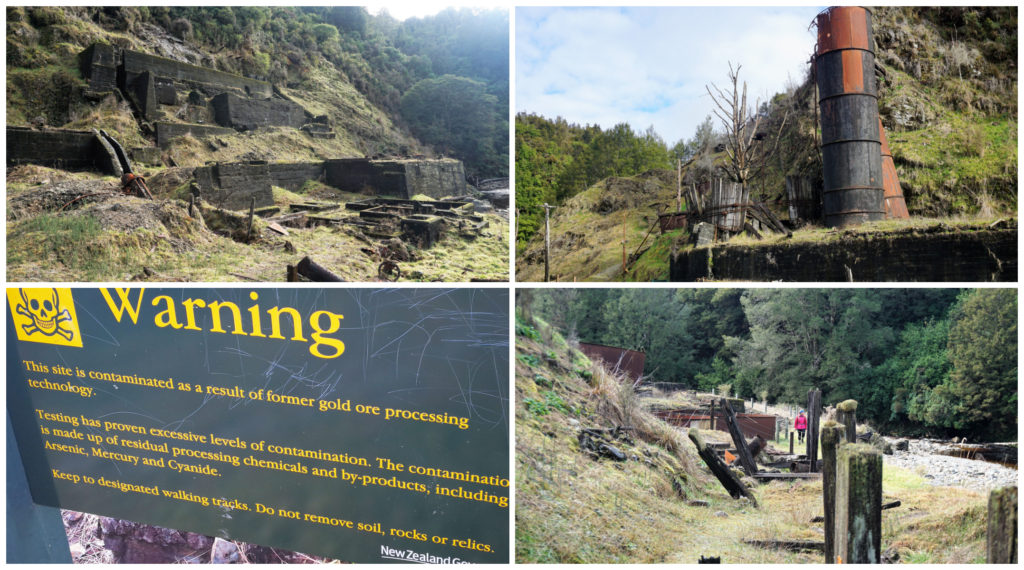
I felt like needing to go through a ‘decontamination process’ after wandering around this site!!
Apparently, the locals got to know which fish they could eat from the stream by the colour of their gills. Pink meant they were good, white meant you left them alone!! Can you imagine that sort of practice going on today?

Photographer: Joseph Divis
Brendon Wilshire collection (copyright)
‘Gold battery near Waiuta’, URL: https://nzhistory.govt.nz/media/photo/gold-battery-near-waiuta,
The Powerhouse
Following the stream, we continued along the track for a further 50 minutes to the site of the old Powerhouse.
The track not only followed the stream, but also the hand-dug water race which ran from the battery to the Powerhouse.
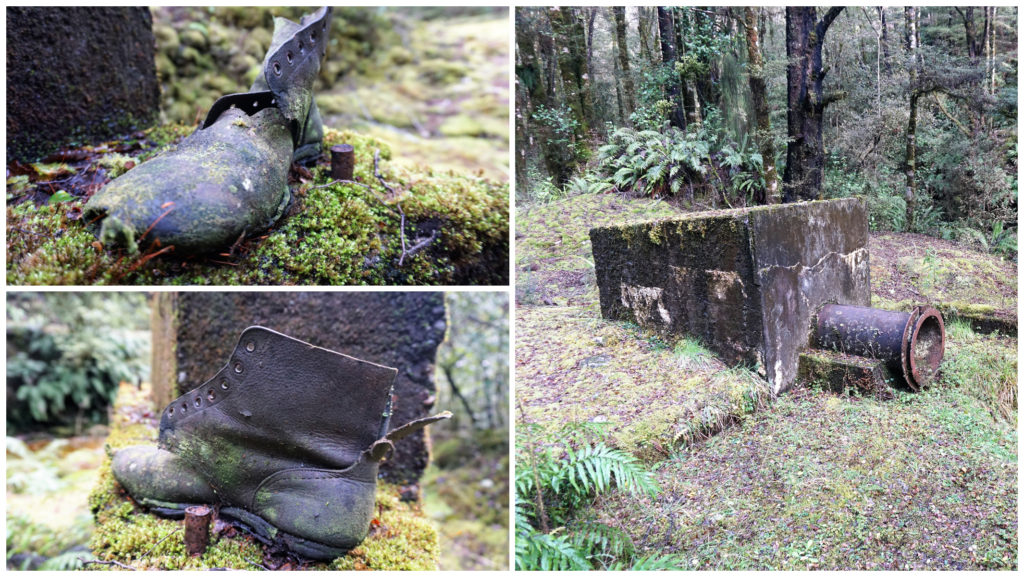
I was more fascinated with this boot than the foundations of the powerhouse. Who owned this boot!!!!
I initially thought that the Powerhouse was used to run the battery. It was the other way round. The water from the battery to the Powerhouse was used to supply electricity to the mining township of Waiuta.
There isn’t much left of the structure, only the concrete base of the building which must have housed all the turbines and generators.
We ended up spending the entire day at Waiuta. We are glad to have had the opportunity to do the area justice.
Click on the link below to view a video of the highlights of our visit to Waiuta.
Alborns Track
As if we hadn’t had enough walking at Waiuta, the next day we braved the 1-degree temperature and set out for Alborns Track.
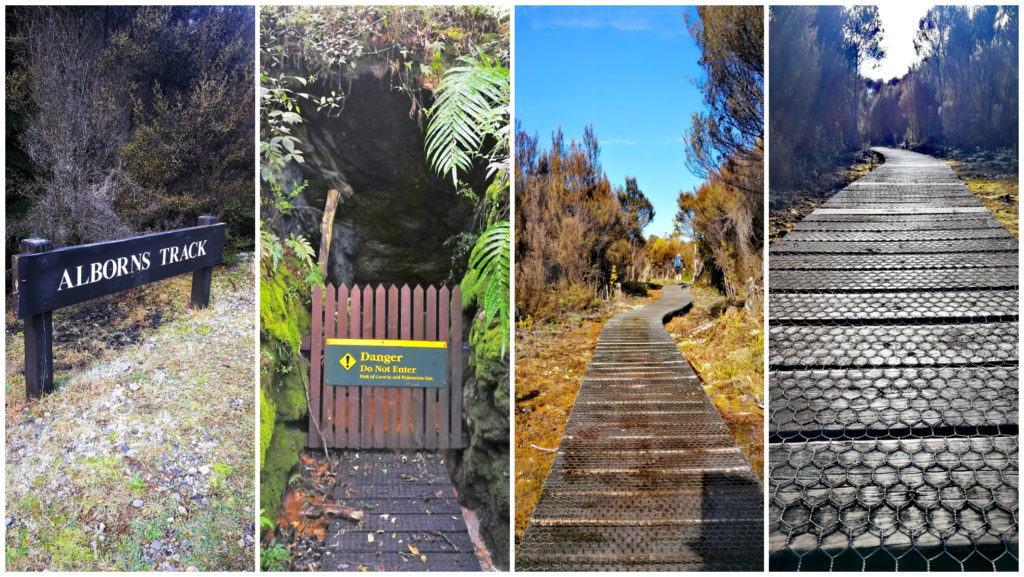
Plenty of old mine shafts and a very impressive boardwalk make this a great walk
Located just south of Reefton, the 1.5hr loop walk took us through scattered old coal mine workings. Some of the track has been closed as the Globe Mine is still operational. We caught glimpses of it in the distance across a man-made lake.
DOC has done a great job of the walking track with numerous board-walks to help protect the regrowth of the vegetation. It is dense with Beech trees, manuka trees and moss-covered growth and old logs.
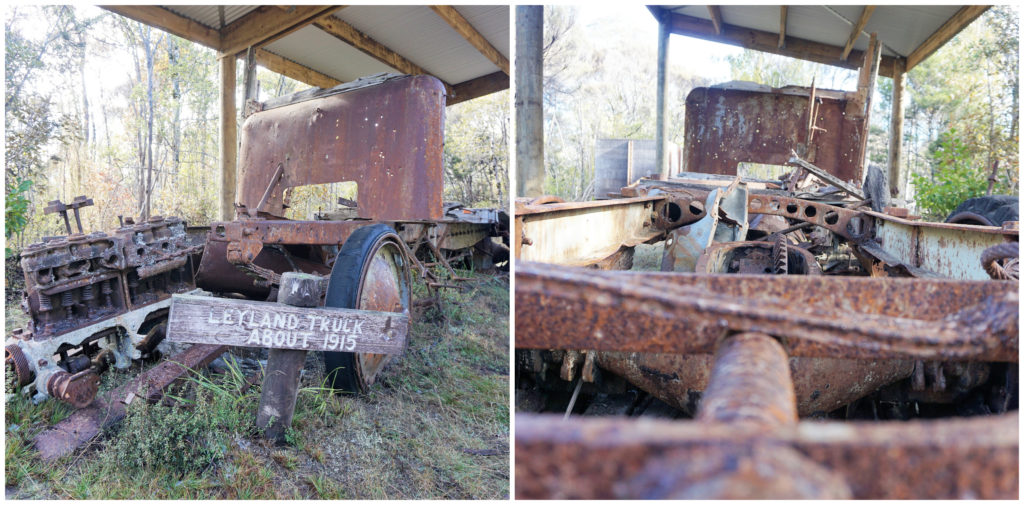
This Leyland’s final resting place
At the top of a steady climb, we came across what was obviously the top of a railway incline. Here we could see evidence of makeshift winch equipment and the rusting remains of an old Leyland truck.
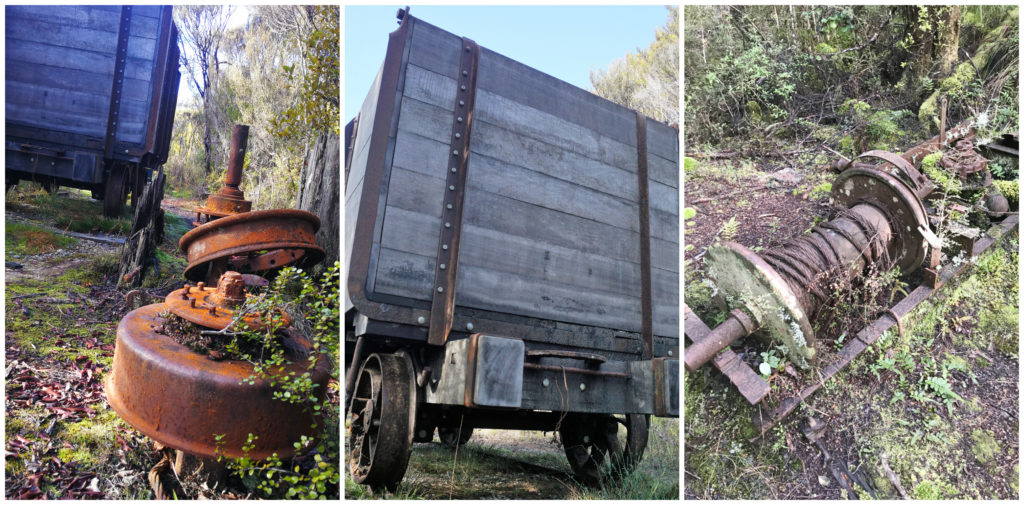
more relics as we wandered down the hill
The track continues downhill via the old railway track doing a nice loop back to the car park.
The Unintentional Lookout
On our way back to Reefton, we spotted a moss-covered roadsign pointing to a Look Out. Never ones to pass on a viewpoint (especially if you can drive to it) we took the detour to see where it would lead us.
Talk about a road less travelled. Goodness me, there was a couple of times I thought that it wasn’t such a good idea. As the road got more narrow, we had to negotiate our way under not one, but two trees that lay across the road. Luckily there was enough height to allow us to skim under them in the ute.
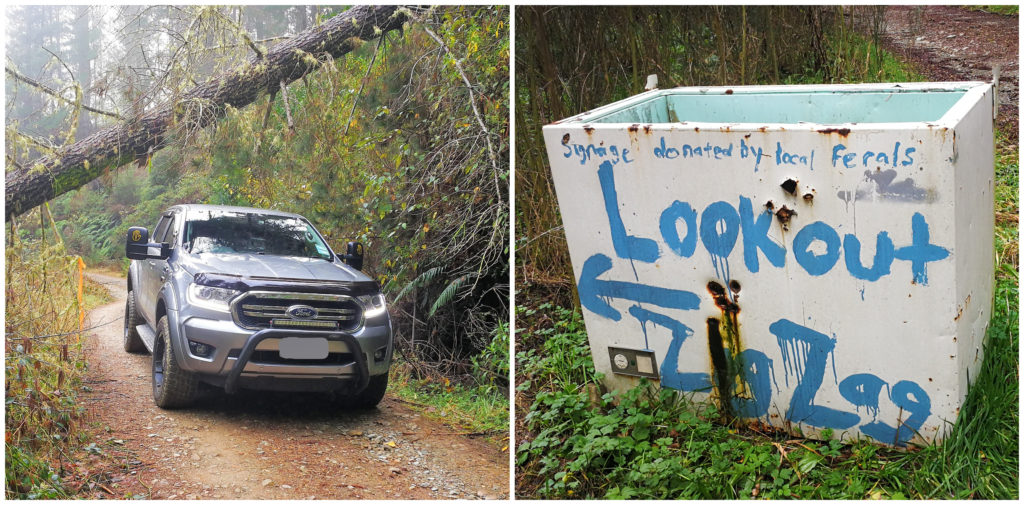
TIMBER!!!!! We followed the ‘feral’ signage to the top
Then we ran out of tarseal and continued to drive up the hillside, across large ruts and holes. It was certainly not a road for larger rigs or caravans!! Thankfully there was nothing coming the other way!
We made it to the top and it turned out to be a service track to a Repeater Station. The township of Reefton stretched out before us. The low cloud and mist wafted along like clouds of smoke below us.
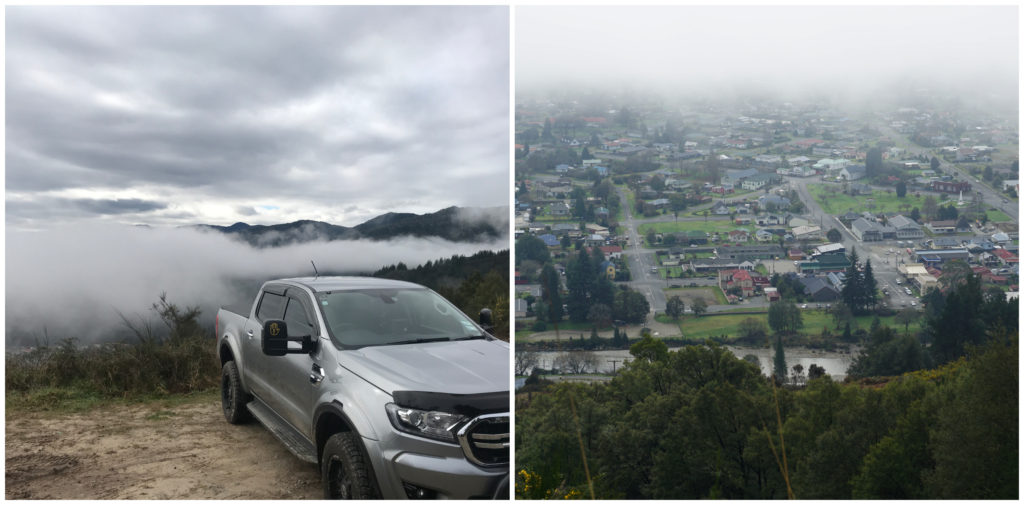
a tailgate lunch with a view and our glimpses of Reefton beneath the mist
We decided it was a great picnic spot. Scotty backed the ute up and lowered the tailgate. We sat munching away at our lunch with the best seats in the house.
Black’s Point
We had every intention of visiting Black’s Point Museum so we took the 2km drive out to the small settlement. The museum wasn’t open. Instead, we took a short wander up the nearby track following Murry Creek.
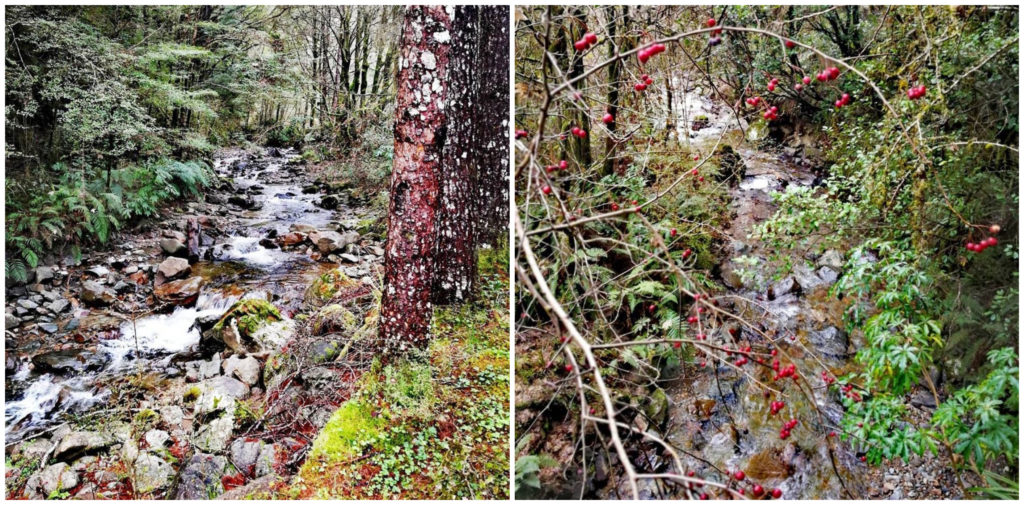
What we did get to see was beautiful
There are various track options that start in this area. The walkways had been taped off and warning signs erected. They were dropping poisonous pellets in the area. The public was discouraged from entering. As we weren’t keen on getting pelted with poisonous pellets, we wandered back to the ute. After all, we do need to save something else to do if we ever return back to Reefton.
Summary
Reefton is teeming with charm and character and has loads to offer with a range of unique activities and attractions.
Click on the link below to see some our highlights of Reefton.
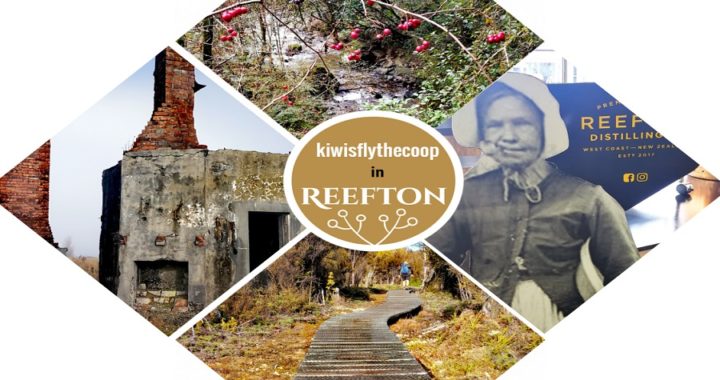
Good old 1080 no wonder I don’t hear any bird life I the forests. Went panning at slab hut and no bird noise.
The Bearded Miners I visited, on entering I dropped a coin in that pot hanging at the entrance and they went into full swing, I think thats the trick
Haha, that must have been my mistake. I dropped a fiver in when we were leaving – should have done it when we arrived!!!